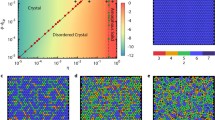Abstract
An attempt is made to gain an understanding for “unusual” properties of extremely thin films and extremely small grains. Lamelles of gold are known to flow together far below the melting point. Independent from temperature a certain load is found, under which a film of given thickness undergoes neither elongation nor contraction. At a certain distribution of building units over the various hierarchic levels—as roughly corresponding to a characteristic ratio of surface to volume—the system is found in a state of optimal hierarchic order (OHO). In passing this state (due to an increase in surface to volume ratio) the system appears to undergo transition into a “meltlike” state. It is proposed that the slope of the curve at the point of inflexion (and intersection) in the plot of load vs. rate of expansion or contraction may serve as a measure of the hierarchic order of the system under consideration. The question is raised in what ways observable changes in structure sensitive properties, such as strength or conductivity, may be related to changes in hierarchic order.
Zusammenfassung
Es wird versucht, die „ungewöhnlichen“ Eigenschaften extrem dünner Filme und außerordentlich kleiner Kristalle verstehen zu lernen. Dabei wird vom bekannten Verhalten von Goldlamellen ausgegangen, welche beim Erwärmen schon weit unterhalb des Schmelzpunktes zusammenfließen. Unabhängig von der Temperatur gibt es für Filme gegebener Dicke und Vorbehandlung eine bestimmte Zuglast, unter der weder Schrumpfung noch Ausdehnung erfolgt. Es wird vorgeschlagen, daß das System bei einer bestimmten Verteilung der Bausteine auf die hierarchischen Ebenen, wie sie annähernd durch ein charakteristisches Verhältnis von Oberfläche zu Volumen gegeben erscheint, einen Zustand optimaler hierarchischer Ordnung (OHO) erreicht bzw. durchläuft. Beim Durchlaufen dieses Zustandes (infolge Erhöhung des Verhältnisses von Oberfläche zu Volumen) scheint das System in einen „schmelzartigen“ Zustand überzugehen. Es wird weiters vorgeschlagen, daß die Steigung am Wendepunkt der Kurven im Diagramm, in dem die Belastung gegenüber der beobachteten Kontraktion oder Expansion des Filmes aufgetragen ist, ein Maß der hierarchischen Ordnung des Systems darstellt. Schließlich wird die Frage gestellt, in welcher Weise beobachtbare Veränderungen von sogenannten strukturempfindlichen Eigenschaften — wie Festigkeit oder Leitfähigkeit — auf Veränderungen der hierarchischen Ordnung beruhen.
Similar content being viewed by others
References
Part III:Gutmann V., Resch G., Inorg. Chim. Acta,72, 269 (1983).
Smekal A., Handbuch der Physik, Band XXIV (Geiger H., Scheel K., eds.). Berlin: Springer. 1933.
Resch G., Gutmann V., Z. physik. Chem. (Frankfurt)121, 211 (1980).
Resch G., Gutmann V., Z. physik. Chem. (Frankfurt)126, 223 (1981).
Gütlich P., Structure and Bonding44, 83 (1981).
Hedvall J. A., Reaktionsfähigkeit fester Stoffe. Leipzig: Barth. 1934.
Hedvall J. A., Heuberger J., Z. anorg. allg. Chem.135, 67 (1924).
Hedvall J. A., Hedin R., Andersson E., Z. anorg. allg. Chem.212, 84 (1931).
Rao C. N. R., Rao K. J., Progress in Solid State Chem., Vol.4 (Reiss H., ed.). Oxford: Pergamon. 1967.
Henry P. A., in: Phase Transitions (Henisch H., Roy R., eds.). New York: Pergamon. 1973.
Sauerwald F., Lehrbuch der Metallkunde des Eisens und der Nichteisenmetalle. Berlin: Springer. 1929.
Chapman Y. C., Porter H. L., Roy. Soc. Proc. A83, 65 (1909).
Tammann G., Boehme W., Ann. Physik12, 820 (1932).
Sawai I., Nishida M., Z. anorg. allg. Chem.190, 375 (1930).
Turner T., Roy. Soc. Proc. A81, 301 (1908).
Schottky H., Göttinger Nachr., Math. Phys. Klasse1912, 480.
Gutmann V., Resch G., Revs. Inorg. Chem.2, 94 (1980).
Chopra K. L., Randlett M. R., J. Appl. Phys.39, 1874 (1968).
Chopra K. L., Thin Film Phenomena. New York: McGraw-Hill. 1969.
Szabó Z. G., Konkoly-Thege I., Proc. 6 ICTA 80, Vol.2, p. 229. Bayreuth: Birkhäuser. 1980.
Murr L. E., Interfacial Phenomena in Metals and Alloys. Reading, Mass.: Addison-Wesley. 1975.
Sennet R. S., Scott G. D., J. Opt. Soc. A40, 203 (1950).
Campbell D. S., Stirland D. J., Blackburn H., Phil. Mag.7, 1099 (1962).
Conrad H., Ertl G., Küppers J., Latta E. E., Surface Sci.57, 475 (1976).
Flemings M. C., Riek R. G., Young K. P., Mat. Sci. Eng.25, 103 (1976).
Oblak J. M., Rand W. H., Met. Trans. B7, 699 (1976).
Oblak J. M., Rand W. H., Met. Trans. B7, 705 (1976).
Benjamin J. S., Met. Trans.1, 2943 (1970).
Gessinger G. H., Met. Trans. A7, 1023 (1976).
Gutmann V., Resch G., Comments Inorg. Chem.1, 265 (1982).
Author information
Authors and Affiliations
Rights and permissions
About this article
Cite this article
Gutmann, V., Resch, G. The hierarchic order in the solid state, part IV States of “optimal hierarchic order” solid—“Meltlike” transitions. Monatsh Chem 114, 839–850 (1983). https://doi.org/10.1007/BF00799946
Received:
Accepted:
Issue Date:
DOI: https://doi.org/10.1007/BF00799946




